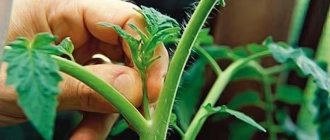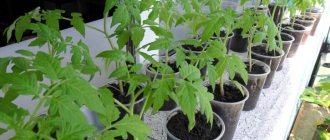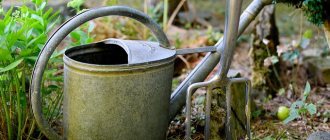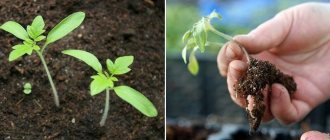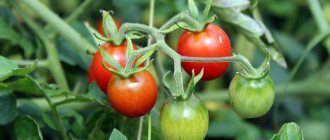Vegetable growing » Tomatoes
1
2770
Article rating
Kira Stoletova
Planting tomatoes greatly affects their future yield. It is important to choose a good place on the site and prepare the soil. Another condition is maintaining the optimal distance when planting. Tomato seedlings can be either purchased or grown independently.
Proper planting of tomatoes
Selection and preparation of beds
It is best to plant tomatoes after cabbage, onions, carrots, pumpkins, and zucchini. It is not recommended to plant tomatoes after other crops belonging to the Solanaceae family. Tomatoes can be affected by late blight and other common diseases. The soil should be neutral or slightly acidic, preferably sandy loam, with good air permeability. You cannot grow the crop in an area that is too wet and shaded: the fruits will be small, not very tasty, and the bushes can be affected by diseases.
The beds for planting need to be prepared in the fall. The area is dug well, weeds are removed, and then fertilizer is applied. For good tomato growth you will need:
- humus, humus or manure diluted with water 4-7 kg per 1 m²;
- superphosphate - 40 g per 1 m²;
- lime or wood ash - 700 g per 1 m².
Tatyana Orlova (candidate of agricultural sciences):
Lime is applied only on acidic soils! On neutral and slightly alkaline soils, the application of lime causes the appearance of non-infectious chlorosis in all plants, including tomatoes, which manifests itself in the form of yellowing (or even whitening) of the upper leaves. The leaf veins remain green.
After the snow has melted, you need to dig up the ground again and remove the remaining weeds. Approximately 10 days before planting, it is necessary to loosen the soil and apply fertilizer again. This time you will need 20 g per 1 m² of superphosphate and potassium fertilizer. Immediately before planting, you can apply 20-30 g per 1 m² of nitrogen fertilizers.
Variety selection
Methods for planting tomato seedlings largely depend on the variety. It is customary to distinguish several varieties of tomatoes:
- greenhouse;
- varieties for open ground;
- universal;
- short;
- tall;
- standard;
- early;
- mid-early;
- late.
Greenhouse varieties can be sown for seedlings earlier, as they are less affected by frost. The distance when planting low-growing varieties may be less than that of tall ones. When choosing a variety, it is very important to take into account the climatic zone and ripening time. The optimal growing season for central Russia is considered to be 100-105 days. For northern latitudes it is better to choose early varieties. In the south, you can plant any tomatoes, including late ones.
When to sow tomato seeds for seedlings?
When sowing seeds for seedlings, it is important to consider the time of planting in the ground. Some people think: the sooner I sow, the sooner it will bear fruit. But if you plant it early, the sprouts will stretch out and in the future will be very weak.
Some people think that length is a very good thing. That it can be placed diagonally in the hole and then more roots will form. But in practice, this method of planting only worsens the survival rate of the plant, because until it takes root, it will not grow further.
Sowing time
- standard ones in 40-45 days,
- medium-sized in 50-55 days,
- tall in 50-60 days.
Preparing seedlings
Before we talk about how to plant tomatoes correctly, we need to talk about preparing the plants themselves. You can buy ready-made seedlings at the market or in a store. This option is practiced by those who have nowhere to grow bushes from seeds. In this case, you need to carefully examine the plants to see if there are any diseases or pests on them. It is advisable to study the characteristics of the varieties you are going to buy.
Land preparation
If you have space in your home, you can easily grow tomatoes for planting. Tomatoes are sowed in cardboard cups, plastic bottles or containers. The soil can be taken directly from the site where you plan to plant bushes in the spring, or you can buy it. The second option is more acceptable, since soil from ordinary gardens can be contaminated with fungi and bacteria.
The soil for planting needs to be prepared
It is recommended to mix turf soil, peat and humus for seedlings in a ratio of 1:1:1. Sometimes 0.5 parts of sand are added to this soil. Substrates that have proven themselves are: coconut, peat tablets. In the latter cases, the bushes are easier to transfer to the garden bed; they do not need to be removed from the tablet; simply place them in the soil on the site. Before sowing seeds, the soil and substrate must be roasted in the oven or scalded with boiling water to destroy fungi and bacteria. It is better to plant in new containers or disinfect old ones well.
Tatyana Orlova (candidate of agricultural sciences):
The soil for growing seedlings should be light, porous, but nutritious. Ordinary garden soil taken from the garden, where adult plants grow well, is not suitable for small seedlings. In the limited volume of the glass, it quickly sours or thickens.
Growing conditions
When sowing tomatoes for seedlings at home on the windowsill, you need to maintain optimal temperature and humidity. Seedlings germinate best at a temperature of 25°C. The humidity for seedlings should first be about 90% (the containers for this are covered with film), then it should be lowered to 60-70%. Seeds are sown in moist soil and not watered until the first shoots appear. They sprout 5-10 days after sowing.
You can grow tomato seedlings at home with or without transplanting; there is no single rule.
The culture tolerates picking well, but it requires effort and time. Some gardeners claim that replanting does not particularly affect the yield. If you keep plants on a windowsill, after 3-4 true leaves appear, they need to be hardened off by taking them outside.
Tomatoes are planted in open ground or a greenhouse 55-65 days after sowing. For this purpose, only the best seedlings are selected.
Seedling care
Shoots appear 5-7 days after sowing.
Until the seedlings emerge, the box with seedlings is kept at room temperature, then the temperature is reduced to 12-15 degrees during the day and 8-10 degrees at night.
When the seedlings get a little stronger, the temperature is again raised to 20-25 degrees.
The recommended air humidity for growing seedlings is 60-70%.
At two weeks of age, the seedlings are planted in separate cups.
Feeding:
- After 10 days, the first fertilizing is carried out with a mixture of potassium salt, superphosphate and urea.
- After another 2 weeks, the tomatoes are fed a second time.
Water the seedlings with warm water in the first half of the day. Watering should be plentiful, but rare.
Plants are planted in the garden at the age of 65-70 days.
On a note! By the time of planting in the ground, the bushes should have a developed root system, many buds on the first cluster, a thick stem, and dark green leaves.
Boarding time
When should you plant tomatoes in open ground? At the time of picking, the seedlings should be 60-70 days old, strong and healthy. The date and time largely depend on the climate and weather conditions in a particular year. It is important that the soil temperature is not lower than 15°C; 20°C is considered optimal. You can measure the temperature with a regular household thermometer by lowering it 8-10 cm into the ground.
Air temperature is no less important for tomato seedlings. During the day it should be between 20-22°C, and at night it should not fall below 15°C. At 12°C, tomato growth stops. The culture is thermophilic - if there is a threat of frost, it is better to use a covered growing method.
Landing times in different regions
Timing for planting tomatoes in beds, depending on the climate zone:
- Southern regions - third ten days of April (early varieties), second ten days of May (mid-late varieties).
- Central Russia (Moscow region, Leningrad region) - from mid-May to early June.
- Northern regions (Ural, Siberia) - from early to mid-June.
If all planting dates are met, you can expect a good harvest. It is also impossible to plant planting material in open ground too late: the fruits may not ripen, especially in cold climates. It is important to monitor the temperature after planting. If the forecast predicts frost, it is recommended to cover the plants with film.
How to make a watering hole for tomatoes
Just digging a hole is not enough to ensure a record harvest of tomatoes. 1 liter of ash is poured into the bottom of each hole, and the top is tightly filled with mowed grass. Herbs can be poured even heaped, it will settle as it rots. But make sure that the stems are without seeds and parts of rhizomes - you don’t need extra weeds in the beds.
Planting tomatoes using the square-cluster method
If you don’t have wood ash, use superphosphate and potassium sulfate - a handful of each fertilizer added to the hole will provide the tomatoes with everything they need.
Tomato planting schemes
The planting pattern depends on the tomato variety.
How to plant tomatoes in the garden? This question often arises among beginning gardeners. There are several schemes; when choosing them, you should take into account the characteristics of the variety, the size of the bushes and the site itself. Planting technology may differ between greenhouse and open growing methods.
Row planting in pits
In one row
The most popular option is row planting of tomatoes. With this method of planting tomatoes, holes are made in several rows, and one bush is planted in each. The distance depends on the size of the bushes.
For low-growing bush varieties:
- distance between bushes - 30-35 cm;
- the distance between rows is 40-50 cm.
For tall varieties:
- distance between bushes - 40-45 cm;
- the distance between rows is 50-60 cm.
In two rows
An option for an ordinary landing is a two-line one. The bushes are placed in paired rows (rows), with large gaps between these pairs.
Distances of low-growing varieties:
- between bushes - 20-25 cm;
- between lines - 40 cm;
- between pairs of lines - 50 cm.
Distances for tall varieties:
- between bushes - 30 cm;
- between lines - 60 cm;
- between pairs of lines - 80 cm.
Nest landing
Another way to plant tomatoes is to use nests. The area is divided into squares measuring 80x80 cm. A hole is dug in the center of each square. A special feature of this technology is that tomatoes are planted several bushes in one hole. The only exceptions are some varieties:
- low-growing and tall varieties - 2-3 bushes per hole;
- bushy varieties with a wide crown - 2 bushes per hole;
- mid-late and late varieties - 1 bush per hole.
Nest planting is best suited for regions with a dry climate. Plants grow more crowded, the soil does not dry out as quickly, which allows you to reduce watering. The bushes are intertwined with roots, after which it is as if one plant is formed. This increases productivity, the fruits are large and tasty.
Tatyana Orlova (candidate of agricultural sciences):
When growing seedlings in cassettes, the seedlings are easily removed from the cells along with the soil, because the roots tightly braid the lump of earth, preventing it from crumbling. Cassette seedlings easily take root in place, experiencing almost no stress during transplantation.
Planting in the spread
The technique is very convenient for large areas and greenhouses. First, a trench about 10 cm deep is dug. Then the seedlings are laid horizontally and buried in soil. The distance between rows and plants must be calculated in the same way as when planting in rows in holes.
Advice from gardeners
Many gardeners who have been growing tomatoes upside down for many years share their experiences and observations. The following tips for growing tomatoes in hanging form will help novice gardeners:
- If there is a large hole in the bottom of the container, the seedling may fall to the ground. To prevent this action, the hole is sealed with paper.
- You should not use black containers for growing tomato plants, as they are susceptible to overheating, and this can lead to the death of the bushes.
- You can make a decorative composition from hanging pots with tomato plants. For this purpose, different varieties of crops with fruits of different shapes, colors and sizes are planted in the neighborhood.
Natalia
Author
Ask a Question
Many gardeners try to grow tomatoes upside down. This unusual method of cultivating vegetable crops has become quite popular due to its ease of care, high yields and the ability to decorate the site with picturesque tomato pots. In European countries, this unique method has been used for quite a long time. It is practical, convenient, beautiful and will soon become very popular among domestic gardeners. Health to you and your loved ones!
Planting in open ground
Now let's take a closer look at how to properly plant tomatoes in the ground. First you need to dig holes or a trench 10-15 cm deep. Some gardeners advise doing this 2-3 days before planting. You can put fertilizer (superphosphate, wood ash, humus, humus) at the bottom, then pour plenty of water into the hole. It is important not to overdo it with fertilizing: tomatoes do not like their excess. If the bed was fertilized in the fall and 10 days before planting, you don’t have to add anything.
It is better to plant on a cloudy day.
For planting, it is best to choose a slightly cloudy day, it may even rain lightly. It is important that before this the seedlings are properly hardened and carefully selected. All weak and diseased plants should be discarded. To harden, pots of tomatoes 2-3 weeks before planting in the ground begin to be taken out into the air, first for 10-15 minutes, then for a couple of hours, the whole day. On the day of transplantation, they are left there for a day.
The seedlings are carefully removed from the containers where they grew so as not to damage the roots. If peat tablets were used for growing at home, there is no need to free the roots from the soil. It is correct to plant such tomatoes directly in the substrate. There should be only 4-5 leaves left on the tomato stems; the excess leaves are removed from below. It is advisable to plant purchased planting material on the day it was purchased. If this is not possible, the roots of the seedlings are wrapped in a wet cloth. They should be planted no later than 2-3 days later.
The hole is watered with a small amount of water immediately before planting, then the bushes are placed in it at an angle of 45° or horizontally. Soil is poured on top of the plants and lightly compacted. If the soil is dry, you can water the tomatoes with a little water. You can also organize drip irrigation of the entire bed using a hose.
Features of growing tomatoes upside down
The essence of the method of cultivating tomatoes with their roots up is the tendency of each plant to stretch vertically. Tomatoes rush to the sun to enrich themselves with solar energy, which they need for a complex biological process - photosynthesis. As a result of this natural maneuver, tomato bushes growing upside down grow well to the sides.
The benefits of growing tomatoes upside down
The unusual way of growing tomatoes has attracted quite a large number of fans due to its many advantages. The main advantages of the method:
- Saving space in the garden. For owners of small garden plots, this method is very convenient. You can plant other plants under hanging containers. In greenhouses, inverted tomato bushes are placed on the second tier, securely fastening the pots to the upper structures.
- Tomatoes ripen much earlier, about 2-3 weeks. There is not much soil in suspended containers; it warms up much faster due to hanging, therefore, the growth and development of the culture also accelerates.
- The likelihood of infection from infectious diseases is reduced to a minimum. Good ventilation of plants, receiving a sufficient amount of solar energy and a high location above the ground surface create unfavorable conditions for the life of pathogens.
- Effortless care. Plants do not need periodic weeding, loosening and pruning of stepsons. The watering process is easy and quick, similar to moisturizing indoor flowers. In addition, minimal irrigation water is used.
- Original designs with plants hanging down will give the site a decorative look.
Disadvantages of growing tomatoes upside down.
Based on reviews from gardeners, the method of growing tomatoes upside down has the following disadvantages:
- Difficulty landing. The difficulty lies in getting the seedlings through the small hole and keeping the soil from spilling out. However, having carried out this operation with one container, it will be easier to cope with others.
- A reliable suspension is required. A pot filled with soil containing a plant is quite heavy. In this regard, the fastening and support must be strong.
- It is necessary to constantly monitor the soil moisture, which dries out quickly in containers with a small capacity.
Which tomato variety to choose for growing upside down?
In order for tomato bushes planted with their roots up to please with beautiful foliage and an excellent harvest, it is necessary to select varieties that perfectly adapt to these conditions. Tomatoes with thin stems and small fruits are most suitable. The varieties most in demand among gardeners are: Rapunzel, Garden Pearl, Ampel Tiger, Wagner Mirabelle.
Planting in a greenhouse
How to plant tomatoes in a greenhouse? The technology is almost the same as in open ground. It is important to properly prepare the soil for tomatoes and organize watering. The technique also has its secrets.
Soil preparation
They begin to prepare the land in the fall. Humus or humus is added to it. A method of fertilizing with humus, which is well suited for closed ground:
- remove the top layer of soil about 20 cm thick;
- dig a ditch;
- take three-year-old humus (it can be prepared in a barrel or compost pit);
- Fill the ditch halfway with humus and cover the bed with the removed layer of soil.
In the spring, such a bed is dug up and loosened.
In early spring, keeping earthworms in the greenhouse is beneficial. They form a very useful substance for plants - humus. The worm passes through itself soil, plant remains, and insects. The output is fermented natural fertilizer. In addition, worms dig tunnels in the ground, loosen the soil and enrich it with oxygen.
Rules for settling earthworms:
- stock up on worms at the rate of 5-10 individuals per 1 m²;
- dig holes in the ground and place 2-3 worms in each;
- cover the hole with earth;
- water the area with a hose.
It is important to cover the greenhouse with film. If the worms do not have time to burrow deep into the ground, they will die during frost.
Planting tomatoes
Tomatoes are planted in a greenhouse 1-2 weeks earlier than in an open garden bed. The technique is almost the same as in a regular garden bed. It is more often recommended to use the trench method in greenhouses. If the variety is tall or the seedlings are large, you can use the snake method:
- dig a hole about 25 cm deep;
- add to the resulting soil a handful of wood ash, 2-3 kg of humus, 1 tbsp. l. phosphate and potash fertilizers;
- mix the earth;
- clean the lower part of the seedling stem so that 4-5 leaves remain;
- lay the stem in the hole so that it twists like a snake (hence the name of the method);
- carefully sprinkle the planting material with a mixture of soil and fertilizers and tamp it down;
- Water the entire area with a hose.
It is important to ensure good watering of the plants in the greenhouse, because natural moisture does not flow there. It is best to equip a special drainage system. If this is not possible, you should connect a hose to the greenhouse. It is important to monitor humidity: overwatering harms tomatoes. In conditions of high humidity, pests easily settle in the greenhouse. Before planting tomatoes there, be sure to disinfect all structures and soil.
How to choose a place to plant tomatoes
Tomatoes are demanding and capricious - they will not grow in the corner of a plot or in the shade, like some unpretentious zucchini. To plant tomatoes, you should set aside the best place in your garden - lighted, warm, well-ventilated. Of course, tomatoes will not appreciate hurricane winds, but stagnation of air and moisture also harms them, because it is this that leads to the development of late blight.
Tomato bushes affected by late blight look as if burned
Tomatoes should also be constantly ventilated in the greenhouse: the doors should be closed in summer only at temperatures below 12°C or in damp, chilly weather.
Care after landing
Proper planting of any tomatoes is only the first step to getting a good harvest. In order for plants to develop, they need to be looked after. When the seedlings take root and begin to stretch upward, they need to be tied to a support. Sometimes combined cultivation of two crops is used. Corn is planted between the rows of tomatoes, then the bushes are tied to strong stalks of the cereal. This method is suitable for the southern regions. In the north, corn will shade out tomatoes.
After 2-3 weeks, the tomatoes are fertilized. To do this, 25 g of nitrogen, 40 g of phosphate and 15 g of potassium fertilizer are diluted in a bucket of water. 600-700 ml of solution is poured under each plant. You need to water the bushes as needed. Most often this is done 3-4 times a week. If it rains, reduce watering to once a week.
In order for tomatoes to ripen well, in the northern regions some of the leaves are removed from the bushes. In the south, this procedure is not done, since the foliage protects the fruits from the bright sun. It is important to monitor whether pests or fungi have appeared on the bushes. For prevention, preventive treatment of tomatoes is carried out with infusion of garlic, tobacco or fungicides. After harvesting, all tops are removed from the garden so as not to contaminate the soil. Before planting tomatoes in the same place another time, you need to maintain a three-year interval.
How to protect tomatoes from diseases
Although a watering hole makes plants strong and hardened, it cannot protect them from diseases. Therefore, you should follow a number of simple rules:
- Spray with fungicides (Profit Gold, HOM, Ordan) on healthy leaves (the first - a week after planting the seedlings in the ground, the last - three weeks before the fruits ripen);
- During the ripening period of tomatoes, water and spray the bushes weekly with solutions of iodine, soda and potassium permanganate. In the first week, prepare a solution of 10 drops of iodine in a bucket of water, in the second - from 2 tbsp. soda in a bucket of water, in the third - a solution of potassium permanganate the color of red wine;
- be sure to tear off the lower leaves on the plants - the trunk at a height of 30-40 cm from the ground should be clean;
- remove the shoots on the bushes, and to get large fruits, at the end of July, cut off the tops of the tomatoes so that the plants do not waste energy on growing green mass.
Everything ingenious is truly simple! You can make watering holes both in the greenhouse and outside. Bushes planted in this way bear fruit for a long time, amicably and do not get sick, because they receive everything they need and do not require close attention from the owner. And this is especially valuable if you can only take care of your green charges on weekends.
